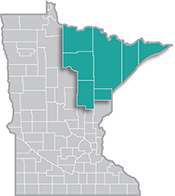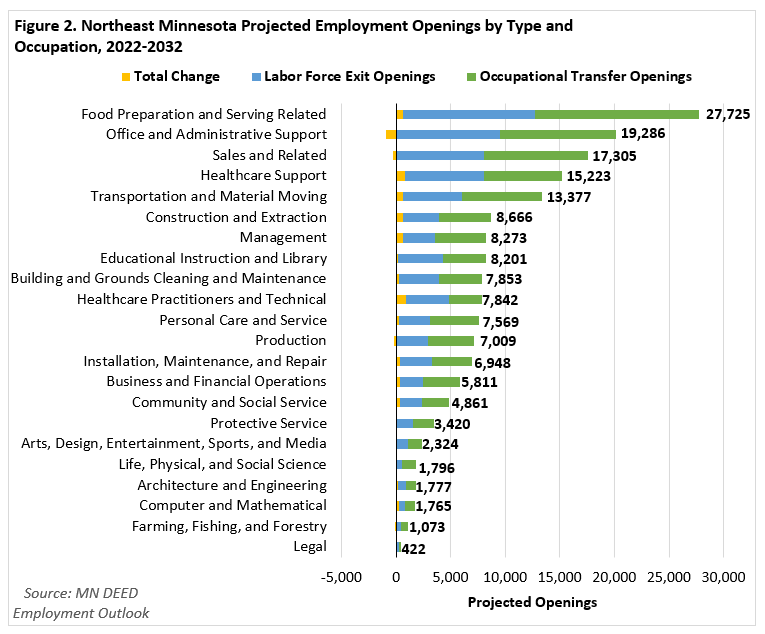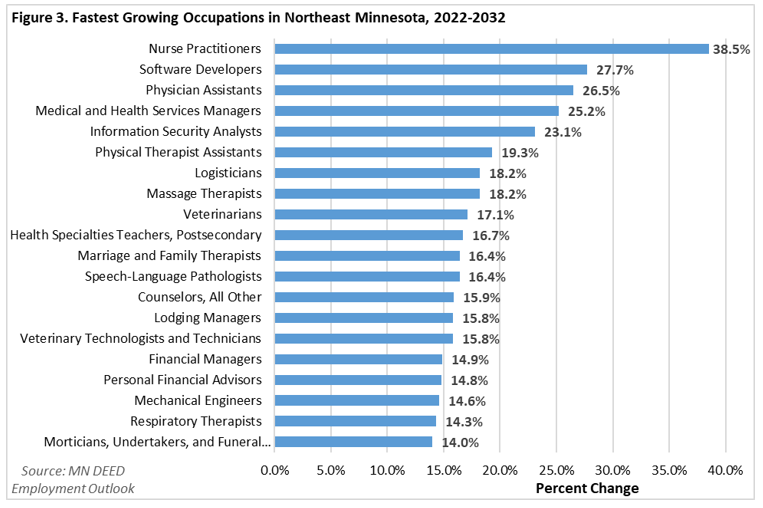 Home to the state's second-largest metro, the Northeast Region has a strong industrial sector, tied largely to the area's abundant natural resources.
Home to the state's second-largest metro, the Northeast Region has a strong industrial sector, tied largely to the area's abundant natural resources.
Most of the manufacturing base centers on mining and forest products industries. More than half of the sector's employment is in paper and machinery manufacturing.
Want the freshest data delivered by email? Subscribe to our regional newsletters.
10/21/2024 2:40:32 PM
Carson Gorecki
Recently published employment projections show how our economy (and workforce) are expected to change over the next 10 years. DEED uses historic employment, labor force, and demographic trends and characteristics to create forward-looking employment estimates at the state and regional level. These projections, created for industries and occupations, serve as important data points for individuals and organizations as they plan for the future workforce.
Regional projections for Northeast Minnesota forecast the addition of 5,157 net new jobs between 2022 and 2032, equaling a percent growth of 3.3%. Compared to historical employment growth, the 2022-2032 period is expected to be below the robust rate of recovery from the pandemic-induced recession, but would exceed the growth seen in the years leading up to 2020. Long-term growth is limited by the demographic realities of a slowly growing and aging population.
By industry, the fastest growth is projected to occur in Management of Companies; Arts, Entertainment, & Recreation; Construction; and Professional & Technical Services. This diverse set of sectors includes those that have grown over the pandemic period such as Construction and Professional & Technical Services, as well as those that have yet to fully recover like Arts, Entertainment, & Recreation. Management of Companies is a relatively small sector that serves to benefit from economic growth in general.
By number of jobs, the most growth is forecast to occur in Health Care & Social Assistance (+2,065 jobs), Accommodation and Food Services (+826 jobs), and Construction (+538 jobs). Those three sectors alone account for two-thirds of the jobs expected to be added (see Figure 1).
At the other end, there are five sectors expected to shrink over the next decade. Agriculture, Forestry, Fishing, & Hunting; Finance & Insurance; and Information continue their trends of longer-term decline, while uncertainties remain for Utilities amid the energy transition, and Retail Trade contends with the rising influence of automation and e-commerce.

At a more detailed level, occupational projections include measures of expected openings by their cause. Our projections forecast that in addition to the 5,157 newly created jobs, there are expected to be many more openings from workers switching jobs (+95,400 transfers) or from leaving the workforce altogether (+78,000 labor market exit openings). This churn of the labor market represents the bulk of the demand for workers (see Figure 2).
By this measure, more than 27,700 openings are forecasted in Food Preparation & Serving Related occupations. Similarly, nearly 19,300 openings are expected in Office & Administrative Support and 17,300 in Sales & Related, despite projected declines for these occupations. These high numbers of openings reflect the size of the occupational groups as well as their higher rates of turnover. Healthcare Support and Transportation & Material Moving occupations are also expected to have to fill more than 13,000 openings over the next decade.

Finally, we can delve into the projections for more than 470 detailed occupations. Nurse Practitioners are expected to be the fastest growing in the region with percent growth exceeding 38%. This reflects the continuing high demand for advance practice providers, as does the high growth projected for Physicians Assistants. Other Healthcare occupations among the fastest growing include Medical & Health Services Managers, Physical Therapist Assistants, Massage Therapists, Health Specialties Teachers, and Respiratory Therapists. Likewise, Software Developers (+27.7%) and Information Security Analysts (+23.1%) represent continued growth and demand for computer occupations across all industries (see Figure 3).
Among the occupations projected to decline the fastest were many Office & Administrative Support ones are most exposed to changes in the way we work, including automation. Secretaries, Administrative Assistants, File Clerks, Disc Jockeys, Data Entry Keyers, Tellers, and Transcriptionists were deemed most likely to see declines. Cashiers and Customer Service Representatives were two of the largest occupations expected to contract.

DEED's employment projections are one of the many important data products produced by the Labor Market Information Office. If you would like to explore regional and state employment projections in more detail, visit our Employment Outlook page or reach out to your regional analyst.
Contact Carson Gorecki at carson.gorecki@state.mn.us.